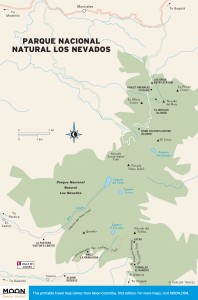
Colombia’s Parque Nacional Natural Los Nevados. Photo © María del Pilar Ruíz, licensed Creative Commons Attribution.

Parque Nacional Natural Los Nevados
This national park covers 583 square kilometers (225 miles) of rugged terrain along the Central Cordillera between the cities of Manizales to the north, Ibagué to the southeast, and Pereira to the northwest. Whether you do a day trip or a multi-day trek, a visit to Parque Nacional Natural Los Nevados allows you to enjoy first-hand the stark beauty of the upper reaches of the Andes, far above the forest line, with its intriguing vegetation and fauna. Within the park are three snowcapped volcanoes, Nevado del Ruiz (5,325 meters/17,470 feet), Nevado del Tolima (5,215 meters/17,110 feet), and Nevado Santa Isabel (4,950 meters/16,240 feet), as well as myriad lakes, such as the Laguna del Otún.This rugged landscape was formed by volcanic activity and later sculpted by huge masses of glaciers. At their maximum extension, these glaciers covered an area of 860 square kilometers (332 square miles). They began to recede 14,000 years ago and, according to a 2013 study by the Colombian Institute of Hydrology, Meteorology, and Environmental Studies (IDEAM), will completely disappear by 2030.
Most of the park consists of páramo, a unique tropical high altitude ecosystem, and super páramo, rocky terrain above the páramo and below the snow line. Páramo is a highland tropical ecosystem that thrives where UV radiation is higher, oxygen is scarcer, and where temperatures vary considerably from daytime to nighttime, when the mercury falls below freezing. It is the kingdom of the eerily beautiful frailejones, plants with statuesque tall trunks and thick yellow-greenish leaves. Other páramo vegetation includes shrubs, grasses, and cushion plants (cojines). The super páramo has a stark, moonlike landscape, with occasional dunes of volcanic ash. Though it’s largely denuded of vegetation, bright yellow plants called litamo real and orange moss provide splashes of color. On a clear day, the views from the páramo or super páramo of the snowcapped volcanoes and lakes are simply stunning.
The black and white Andean condor, vultur gryphus, with its wingspan of up to three meters (10 feet), can sometimes be spotted gliding along the high cliffs in the park. While it is estimated that there are over 10,000 of the birds on the continent (mostly in Argentina), there are few remaining in Colombia. Some estimates report that by the mid-1980s, there were no more than 15 left in Colombia, due in large part to poaching by cattle ranchers. In an effort to boost their numbers in Colombia, a reintroduction program was initiated in the park (and in other parts of the country) in the 1990s in conjunction with the San Diego Zoo, where newborns were hatched. Today it is estimated that there are 200-300 condors soaring above Colombia’s Andean highlands. Numbers of the endangered birds in Los Nevados range 8-15. Other fauna includes spectacled bears (oso de anteojos), tapirs, weasels, squirrels, bats, and many species of birds.
The Nevado del Tolima and Nevado del Ruiz volcanoes are considered active, with the Ruiz presenting more activity. In 1986 it erupted, melting the glacier, which in turn created a massive mudslide that engulfed the town of Armero, burying an estimated 20,000 of the town’s 29,000 residents.
The Northern Sector of the park includes the Nevado del Ruiz, with its three craters (Arenales, La Piraña, and La Olleta), and extends south to the extinct Cisne volcano and Laguna Verde. This part can be accessed by vehicle.
The Southern Sector includes everything from the Nevado Santa Isabel south to the Quindío peak, as well as Nevado del Tolima. This area has fewer visitors as access is only by foot or by horse, from Manizales, Pereira, Salento, or Ibagué.
Excerpted from the First Edition of Moon Colombia.